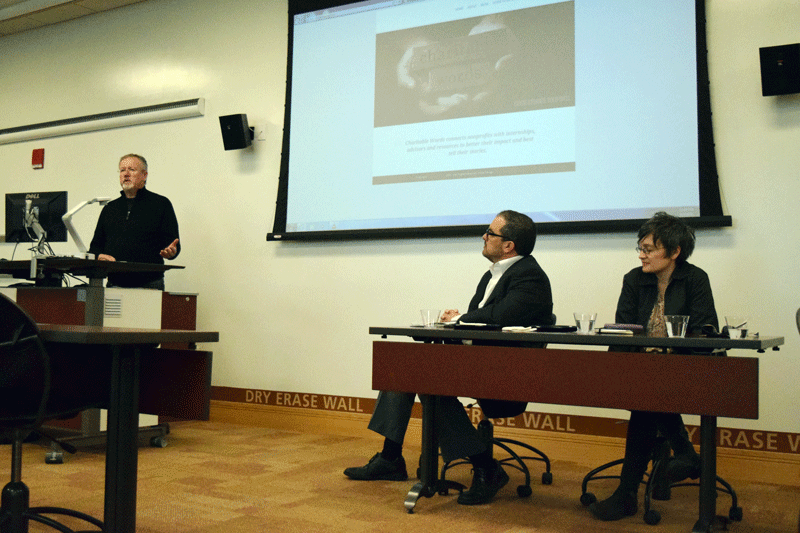Fighting for responsible journalism
Local journalists Tom Callinan, Elissa Yancey and Bob Driehaus spoke to students Monday at Griffin Hall during the Lunch with the Pros event.
In the midst of one of the most negative presidential campaigns in history, three local journalists made the case for positive and responsible journalism April 4 at NKU.
Tom Callinan, Elissa Yancey and Bob Driehaus spoke to a group of students and faculty at the Society of Professional Journalists’ Lunch with the Pros event at Griffin Hall.
The three emphasized the importance of telling more than just the story on the surface of an event. They encouraged journalists to dig deeper to tell the full story of what is happening.
They also discussed restorative journalism, which tends to focus on the battle to overcome obstacles and highlighting solutions rather that problems.
With sensational news headlines flooding social media, all three encouraged future journalists to dig deeper than an outrageous statement that was published in the name of website traffic.
Callinan, founder and director of the nonprofit Charitable Words, lamented the increased importance of the online page click as a measuring tool for journalism outlets.
“The problem is, you’re always going to have the pressure for page views,” Callinan said. “Someone made the comment that 50 years ago if they would have had measurements like that, what would have become of journalism?”
Callinan said it’s the amount of time that readers spend looking at the story that shows the true level of engagement between a journalist and the audience.
“What I encourage people is don’t look at page views, or clicks, look at time spent on the story,” Callinan said. “Three minutes is forever right now. If you can get a couple minutes of engagement, that’s a much richer relationship with readers than a quick click and on to the next story. That’s what this type of storytelling does encourage is a deeper relationship with readers. It’s not easy.”
Driehaus, WCPO education reporter, said in-depth journalism is vital to break through the flood of sensational, quickly-produced stories.
“This type of journalism – you really can’t overstate it,” Driehaus said. “It’s critical to society and to the world in general. If we descend into biased, ethically questionable reporting where the facts have not been checked – and we see it all the time on Facebook and social media. If that becomes the norm, we’re in big trouble because you’ve got to have some sources to make really important decisions.”
Yancey, a member of Images and Voices of Hope, encouraged the audience to find examples of outstanding and positive journalism and share it, rather than sharing the negative examples of journalism.
“It is hard to break through the white noise, or the loud noise, or the screaming and the yelling,” Yancey said. “But, to me, you are what you share on social media. So as long as we don’t buy into the sharing and the promoting – and in some cases the bemoaning and complaining about, because it still highlights that work.
“So instead, highlight the work that makes you proud to be a part of this profession. I think when you do that, it kind of helps your lens sharpen and focus, and I think that gives you a little more power to face another day of it.”
Restorative journalism is an opportunity to tell the stories that have gone untold, Yancey said.
“I think what is really important for young journalists and students at all levels to understand is that as the media world expands, so do media opportunities,” Yancey said. “So this is yet another tool in the journalism arsenal – the truth teller and the story teller and working to shed light into places where there hasn’t been light. Be open to different ways of approaching stories, and to consider different kinds of questions they can ask that might lead into different directions.”
Callinan said even some websites that produce mostly click-inducing content are starting to produce stronger journalism.
“It’s a big, big dilemma right now,” Callinan said. “My daughter works for BuzzFeed. Even BuzzFeed is trying to become more contextual with some of its stories. Then they’ll go right back to kittens and things like that. I don’t think it’s either/or. I think we’ve got to make it ‘and.’ We’re going to do this and we’re going to do this.”
Driehaus said despite the fact it sometimes gets buried under sensational journalism, good journalism is still out there to be found.
“I still think there are a lot of great media out there doing that,” Driehaus said. “The problem is the proliferation of the rest of it that comes in. Then we all get thrown into the same pool, where a lot of people can’t differentiate from the organization that has a lot of professional people living up to a code of ethics and a set of professional standards.
“For everyone, I would just encourage them to find reliable, fact-based journalism because it’s still out there.”
Two restorative narrative pieces were also featured during the event. Sara Drabik, NKU assistant professor of electronic media and broadcasting, featured a clip from an upcoming documentary, “Finding Asylum, The Power of Words.” Yancey showed part of a story she helped develop for WCPO.com entitled, “A Prayer for Winton Terrace.”
Lunch with the Pros is an event co-sponsored by the NKU and Cincinnati Pro Society of Professional Journalists chapters and The Northerner.


